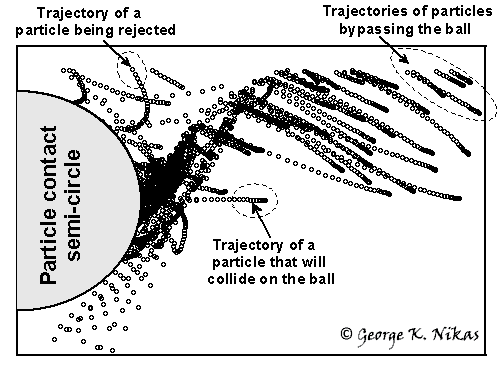
Project: Particle entrapment in an EHD contact of a ball rolling-sliding on a flat surface.
Client: SKF Engineering & Research Centre B. V. (The
Netherlands) 
Researcher: George K. Nikas (Imperial College London, Mechanical Engineering Department).
Supervisors:
Dr Richard Sayles (Imperial College London, Mechanical Engineering Department).
Dr Stathis Ioannides (SKF and Imperial College London).
Project duration: 3 months (1996).
Technical report: A technical report was written by Dr Nikas and distributed to the supervisors of the project. The 79-page report contains 56 figures and 103 detailed equations.
Related
computer software: program SKF. Solid
particle entrainment and entrapment analysis in elastohydrodynamic
contacts. Written in Fortran. Code length: 798 lines. Latest version:
1.4.1.
Summary
This project was about the theoretical modelling of the entrainment and entrapment of small, solid, spherical particles in a sliding-rolling elastohydrodynamic point contact of a ball on a plane. The model consists of two parts.
The first part deals with the solution of the three-dimensional Navier-Stokes equations for a viscous, incompressible fluid to find how a particle behaves in the flow as the ball moves and rotates with constant speeds on the plane. As a result, the probability of a particle to end on the ball (collide with the ball) or to bypass it are estimated. The latter is achieved by solving the equation of motion of a particle in the fluid flow.
The second part deals with what happens when a particle collides with the ball. An entrapment criterion is used to find if the particle will be temporarily rejected or if it will be trapped between the ball and the flat surface.
Particles which are rejected many times may accumulate in the inlet zone of the contact and cause fluid starvation and scuffing. On the other hand, particles that are entrapped could damage the contact surfaces by abrasion or indentation.
An example of the simulation is presented in the next figure, which shows 30 possible trajectories of a 20 micron spherical solid particle left in front of a ball rolling-sliding on a flat surface. The film thickness far away from the ball is 100 microns. The particle is left on the flat and is affected by the fluid flow created by the moving ball. Depending on its initial position, the particle may collide with the ball, become entrapped, be rejected by the ball, or completely bypass it. The "Particle contact semi-circle" is the line defining the imaginary boundary where a particle will come in first (undeformed) contact with both the ball and the flat (that is, the particle cannot enter that semi-circular area without being deformed first).

30 possible trajectories of a 20 micron particle left on the upper half area of the graph.
This is a very detailed study but, with the aid of the developed computer program, the risks of damage can be assessed quickly for any operating conditions (contact speed, film thickness, particle size, etc).
Publications of the author related to this work (most recent first)
Nikas, G. K. Effects of operating conditions and friction on the entrapment of spherical debris particles in elliptical contacts. Proceedings of the Institution of Mechanical Engineers, Part J: Journal of Engineering Tribology, 2007, 221(6), 727-741.
Nikas, G. K. A mechanistic model of spherical particle entrapment in elliptical contacts. Proceedings of the Institution of Mechanical Engineers, Part J: Journal of Engineering Tribology, 2006, 220(6), 507-522.
Nikas, G. K. Particle entrainment in elastohydrodynamic point contacts and related risks of oil starvation and surface indentation. ASME Journal of Tribology, 2002, 124(3), 461-467.
Nikas, G. K. Mathematical analysis of the entrapment of solid spherical particles in non-conformal contacts. ASME Journal of Tribology, 2001, 123(1), 83-93.
Nikas, G. K., Sayles, R. S., Ioannides, E. Effects of debris particles in sliding/rolling elastohydrodynamic contacts. Proceedings of the Institution of Mechanical Engineers, Part J: Journal of Engineering Tribology, 1998, 212(5), 333-343.
Nikas, G. K., Sayles, R. S., Ioannides, E. Effects of debris particles in sliding/rolling EHD contacts. Abstracts of papers of the 1st World Tribology Congress, 8-12 September 1997, London, England, p. 271.